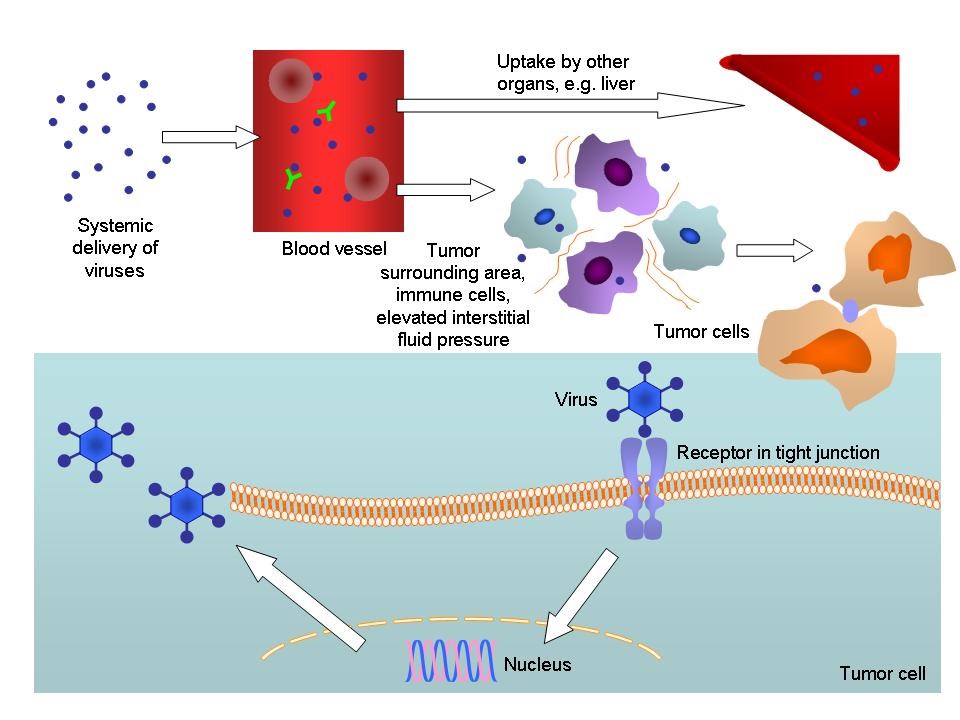Approaches to Delivery of Oncolytic Viruses
Delivery of Oncolytic Viruses
Oncolytic viruses have the potential to powerfully and selectively kill cancer cells and have shown impressive efficacy in preclinical and clinical settings. However, their potential can be restricted by inefficient delivery into the complex tumor environment. Thus, the efficient delivery of oncolytic viruses remains a significant challenge in the field of oncology, limiting their therapeutic effect. Cancer patients have many antiviral defense mechanisms that all need to be penetrated or overcome for the oncolytic virus therapy to be effective. For example, oncolytic viruses in the blood can be neutralized by antibodies and complement, bound by receptor-positive non-target cells, or cleared by phagocytes.
A variety of delivery methods have been employed for these oncolytic virus agents; among them, the intratumoral delivery is the most widely used. A broad range of oncolytic viruses has been delivered via intratumoral injection in treating easily reachable solid tumors. However, the result of inaccessible or metastatic disease is still overcoming. So that, systemic delivery of oncolytic viruses affords attractive options to treat not only the primary tumor but also the advanced/metastatic disease or the inaccessible disease. Maximizing delivery to infect tumor cells has a profound impact on the degree to which the oncolytic viruses propagate from infected cells for curative therapy.
 Fig.1 Systemic delivery of oncolytic viruses. (Wong, 2010)
Fig.1 Systemic delivery of oncolytic viruses. (Wong, 2010)
Current Approaches to Delivery of Oncolytic Viruses
Many prior studies have been done to optimize the systemic delivery of oncolytic viruses. Several approaches can be taken to effectively and uniformly deliver enough quantity of oncolytic viruses to sites of tumor growth to seed a destructive tumor infection. These benefits include the maximization of the drug concentration at the target lesion with a lower dose where they are maximally retained with limited elimination.
- Biocompatible polymers for oncolytic virus delivery
- Active retargeting for oncolytic virus delivery
- Ultrasound and microbubble for oncolytic virus delivery
- Magnetic targeting and penetration for oncolytic virus delivery
- Cell carrier systems for oncolytic virus delivery
The biocompatible polymers shielding relies on active delivery, where the physical properties of polymers can be used to promote the monitoring and targeting of the specific tissues. In this case, shielding can be done by physical interface with biomaterials such as coating with polymers or biodegradable nanoparticles, liposomes, or copolymers.
Oncolytic viruses in polymer-coated ligands may improve virus uptake and enhance the active retargeting of transfected tumor cells, mainly when administered systemically. The oncolytic virus infectivity can be restored by incorporating cell-targeting ligands into the polymer coating.
Oncolytic viruses have shown efficacy in rapid delivery in response to a localized trigger with ultrasound and microbubble. Ultrasound application in the presence of microbubbles induces the disturbances to the membrane, which can facilitate the rapid delivery and release of drugs into cells.
Magnetic nanoparticles, which can be combined with the intrinsic penetrability of magnetic fields into human tissue, open the delivery of oncolytic viruses to targeted sites within the body using a magnetic force.
Cell-based delivery is another shielding approach which relies on passive delivery given that direction and flow of virus propagation are dependent solely on the cell-based properties towards the target organ or tissue.
Based on our well-established OncoVirapy™ platform and abundant experience in oncolytic virus development, Creative Biolabs can provide first-class oncolytic virus construction and oncolytic virus engineering services to meet your specific goals in a timely and cost-effective manner.
Reference
- Wong, H. H.; et al. Oncolytic viruses for cancer therapy: overcoming the obstacles. Viruses. 2010, 2(1), 78-106.
